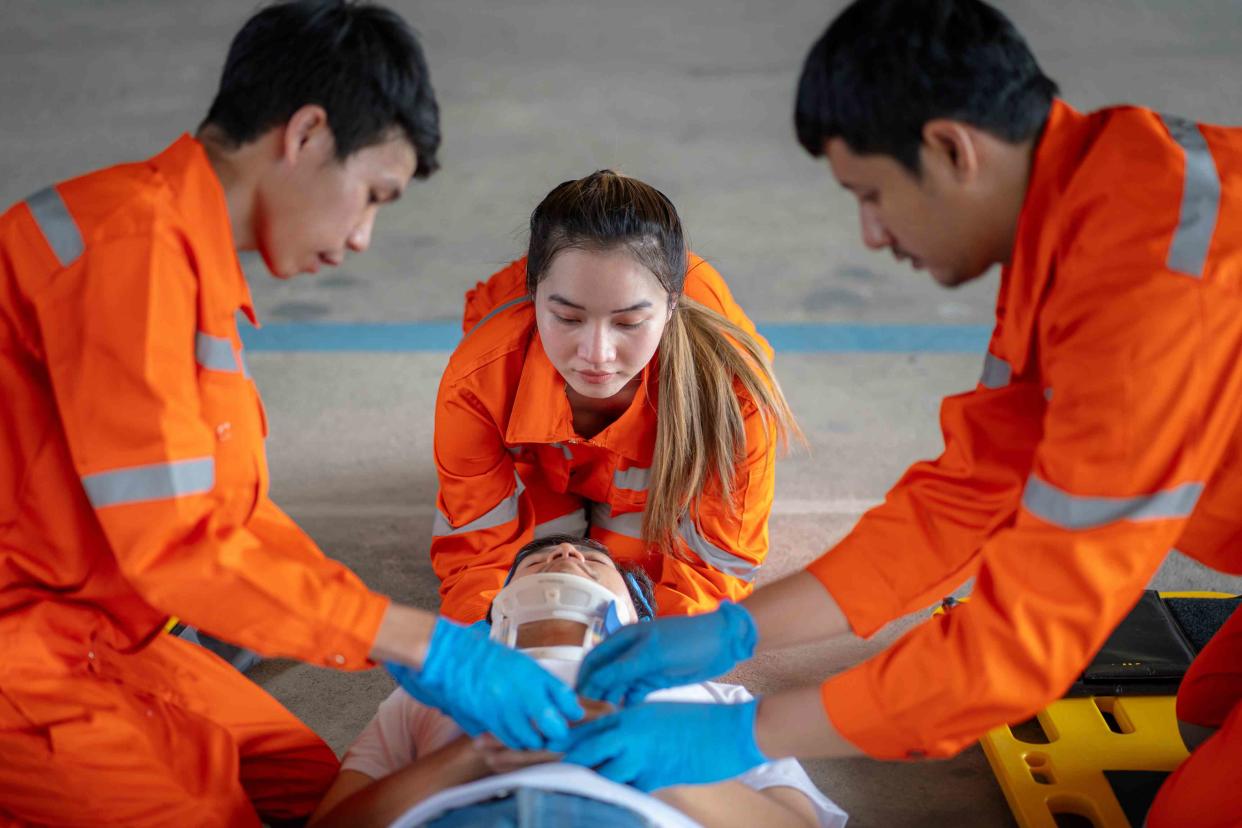This Rapid Blood Test Could Detect Concussions and Other Brain Injuries

Pipat Wongsawang / Getty Images
Fact checked by Nick Blackmer
Key Takeaway
The FDA cleared a rapid blood test for mild traumatic brain injury.
The test can help a medical provider determine if someone should get a CT scan in 15 minutes.
Blood biomarker tests like this one can make brain injury diagnoses more objective and accessible, experts say.
The Food and Drug Administration (FDA) cleared a rapid blood test to help assess mild traumatic brain injuries (TBI), including concussions, in adults.
The Abbott i-STAT Alinity test can help providers determine whether a patient would benefit from a CT scan in 15 minutes. The results can help rule out the need for a CT scan if no sign of injury is detected, saving patients time, money, and radiation exposure.
More than half of people who suspect they have a concussion never get it checked, according to Concussion Awareness Now. There were an estimated average of 190 TBI-related deaths a day in the United States in 2021.
“For the first time ever, we have a blood test that gives objective evidence of whether a patient has injured his or her brain,” said David Okonkwo, MD, PhD, director of the Neurotrauma Clinical Trials Center at the University of Pittsburgh and clinical core leader at Transforming Research and Clinical Knowledge in Traumatic Brain Injury (TRACK-TBI), the research group that developed the i-STAT technology.
“One of our biggest challenges in evaluating and treating patients with concussions and traumatic brain injuries is getting the diagnosis correct and identifying the people who are at risk for serious consequences as fast as possible,” Okonkwo added. “These blood tests are the most powerful tools ever for just those purposes.”
An earlier version of the test, cleared in 2021, had to be sent to a laboratory for analysis. The new test can be used in more healthcare settings, including emergency departments, urgent care clinics, and athletic complexes with qualified medical staff. The clearance could pave the way for brain injury testing in non-healthcare settings, like on the sidelines of sporting events.
“You don’t have to ship the blood sample off somewhere to have it processed. It opens the door to this test now being used day in and day out in numerous sites, from urgent care centers and emergency rooms to primary care offices, to medics in the military deployed into conflict zones, to health care providers on the sidelines of athletic events,” Okonkwo said.
Related: How Concussions Are Diagnosed
Improving Upon CT Scans
To diagnose TBI, a clinician performs an exam of the person’s motor and sensory skills, their coordination and balance, changes in their mood and behavior, and more. Some tools, like the CDC’s Acute Concussion Evaluation and the Glasgow Coma Scale, give clinicians a guide for those exams.
That process relies on clinicians’ observation of a patient and the patient’s ability to recount the injury event, which could be difficult with impaired brain function.
A clinician may also recommend a CT scan or other imaging. While brain scans can help identify brain bleeding and injury, they often miss other signs of TBI, said Hollis Bell, MD, CPE, an attending physician at the Shirley Ryan AbilityLab Brain Innovation Center.
“Especially in the case of mild TBI, a CT scan of the brain can look completely normal, but the cells aren’t functioning normally,” Bell told Verywell in an email. “This type of brain scan, which is the most accessible in most communities, isn’t the perfect diagnostic tool.”
Using a blood biomarker test alongside other tools gives clinicians more objective evidence of brain cell injury, which could lead to a more accurate diagnosis. Bell said blood biomarker tests can reduce the likelihood of people getting unnecessary CT scans and avoid the cost and radiation exposure that they come with.
Related: How to Tell If You Have a Concussion
How i-STAT Detects Brain Damage
The i-STAT test works by detecting biomarkers of brain damage in the blood.
When someone hits their head or suffers a brain injury, the cells in their brain release certain proteins and other molecules into the bloodstream. Researchers are beginning to understand which of those biomarkers are associated with different types and degrees of brain injury.
The i-STAT test detects the proteins glial fibrillary acidic protein (GFAP) and ubiquitin C-terminal hydrolase L1 (UCH-L1). These proteins are released from glial cells and neurons, respectively, and only show up in the blood after mild brain injury, Okonkwo said.
The TRACK-TBI team is currently testing the i-STAT on people younger than 18 to get approval for the use of the test in teens and children.
The test can’t yet tell scientists about the severity of a person’s head trauma, but Okonkwo said that he has seen convincing evidence that higher levels of GFAP and UCH-L1 indicate more severe head trauma.
In the future, Okonkwo hopes that blood tests will be able to identify if a patient has a concussion without relying on confirmation from a follow-up CT scan.
Biomarker tests are also revolutionizing diagnosis and care for other diseases, such as prostate cancer and heart disease.
Bell said researchers are working to understand when certain biomarkers appear in the blood after brain injury and which ones indicate the severity of head trauma. That work could lead to more robust tools for quickly diagnosing different forms of TBI.
“Biomarkers are definitely part of the future of brain injury care, and not just for concussion,” Bell said. “They will revolutionize our ability to diagnose, treat, and monitor more accurately and less expensively than the current care models in use.”
Read Next: What Are the Long-Term Effects of a Concussion?
What This Means For You
If you suffered a head injury, it’s best to get it checked out by a trained medical professional as soon as possible. The i-STAT blood test can only detect biomarkers of brain injury in the first 24 hours.
Read the original article on Verywell Health.

